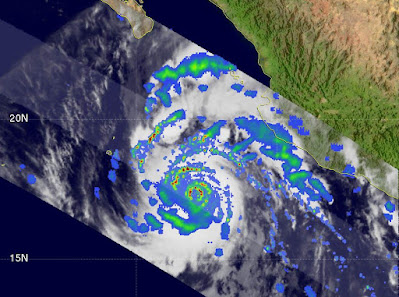Hurricane Jimena (2009) – Detailed Overview & Impact Guide
Hurricane Jimena (2009) was a major and highly destructive tropical cyclone in the Eastern Pacific. At its peak, Jimena reached Category 4 intensity, making it one of the most powerful storms to threaten the Baja California Peninsula in decades. Its rapid intensification, large wind field, and slow movement near land created widespread flooding, wind damage, and humanitarian challenges.
1. Formation and Strengthening
Hurricane Jimena originated in late August 2009 from a tropical disturbance off the coast of southwestern Mexico.
Development Timeline:
-
August 28: System begins organizing into a tropical depression.
-
August 29: Strengthens into Tropical Storm Jimena.
-
August 30: Rapid intensification begins—Jimena becomes a Category 4 major hurricane.
-
August 31: Reaches peak intensity with:
-
Sustained winds: ~250 km/h (155 mph)
-
Pressure: ~931 mbar
-
Category: High-end Category 4 approaching Category 5
-
Jimena became one of the strongest Pacific hurricanes of the 2000s, fueled by extremely warm sea-surface temperatures.
2. Path and Land Interaction
Jimena tracked northwest along the Pacific coastline, steadily approaching the Baja California Peninsula.
Key Path Points:
-
Stayed well offshore mainland Mexico but close enough to cause dangerous surf and rain.
-
Threatened the tourist and fishing regions of Baja California Sur.
-
Eventually made landfall on the Baja Peninsula as a weaker hurricane, then degraded into a tropical storm.
-
Moisture from Jimena crossed into northern Mexico and parts of the U.S. Southwest, producing additional rainfall.
3. Wind, Rain & Storm Impact
Even after weakening from Category 4 status, Jimena carried a massive rain shield and strong wind field.
Major Hazards:
• Wind Damage
-
Strong winds damaged homes made of lightweight materials.
-
Power outages became widespread across Baja communities.
• Flooding & Mudslides
Jimena’s slow movement near land produced extreme rainfall, including:
-
Flooded streets, villages, and arroyos
-
Damaged bridges and roads
-
Landslides in mountainous regions
-
Isolated towns for days
Rainfall exceeded 300 mm (12 inches) in some areas.
• Coastal and Marine Damage
-
High surf and storm surge affected ports and marinas.
-
Fishing fleets suffered equipment losses.
-
Large waves eroded beaches and coastal structures.
4. Humanitarian & Economic Effects
Hurricane Jimena caused significant disruption to life in Baja California Sur:
Evacuations
-
Thousands of residents and tourists were evacuated from low-lying and coastal areas.
-
Emergency shelters filled rapidly, especially in Santa Rosalía, Ciudad Constitución, and Loreto.
Property Damage
-
Houses made of wood, tin, or adobe suffered major destruction.
-
Flooding severely damaged businesses, schools, and public facilities.
Agriculture Impact
-
Crops, livestock, and irrigation systems were heavily affected.
-
Rural communities faced long-term economic effects due to crop losses.
Water & Electrical Systems
-
Water supply lines were damaged.
-
Power outages lasted days to weeks in some regions.
5. Aftermath & Recovery Efforts
Post-storm recovery involved:
• Emergency Response
-
Mexican Navy and civil protection teams deployed to deliver food and clean water.
-
Roads were cleared using heavy machinery to reconnect isolated populations.
• Health & Safety
-
Standing water raised concerns of mosquito-borne diseases.
-
Authorities distributed sanitation supplies to reduce contamination risks.
• Long-Term Recovery
-
Rebuilding of homes and public buildings
-
Restoration of electricity and water infrastructure
-
Assistance to fishermen and farmers whose livelihoods were disrupted
Despite severe damage, fatalities remained relatively low thanks to early warnings and evacuations.
6. Historical Significance
Hurricane Jimena (2009) is remembered as:
-
One of the strongest hurricanes to approach Baja California Sur.
-
A rare Category 4 hurricane threatening this region.
-
A storm that demonstrated the vulnerability of Baja’s rural and coastal communities.
-
A major case study for emergency preparedness in the Eastern Pacific.
Jimena is often compared to other powerful Pacific storms like Hurricane Kenna (2002) and Hurricane Odile (2014) due to its intensity and impact.
Hurricane-jimena






